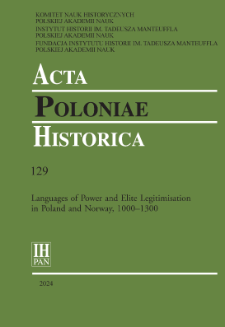
Object
Title: Trimming the Tangle of Legend: Heroic Haircuts, Materialising Meals, and the Legitimisation of Dynastic Succession in Norwegian and Polish Foundation Narratives
Subtitle:
Acta Poloniae Historica T. 124 (2024), Languages of Power and Elite Legitimisationin Poland and Norway, 1000–1300 ; Languages of Power and Elite Legitimisationin Poland and Norway, 1000–1300
Institutional creator:
Polska Akademia Nauk. Komitet Nauk Historycznych
;
Polska Akademia Nauk, Instytut Historii im. Tadeusza Manteuffla
![]() ;
Fundacja Instytutu Historii im. Tadeusza Manteuffla Polskiej Akademii Nauk
;
Fundacja Instytutu Historii im. Tadeusza Manteuffla Polskiej Akademii Nauk
![]()
Contributor:
Instytut Historii Polskiej Akademii Nauk
Publisher:
Instytut Historii im. Tadeusza Manteuffla Polskiej Akademii Nauk ; Fundacja Instytutu Historii im. Tadeusza Manteuffla Polskiej Akademii Nauk
Place of publishing:
Description:
Abstract:
The medieval origin narratives of both Poland and Norway feature dynastic founders who came to power following a ritualistic haircut. In the Polish tradition, Siemowit of the Piast dynasty is anointed duke after his coming-of-age haircut, which is administered by two mysterious strangers; in the Norwegian version, Harald Fairhair vows to only cut his hair after he has united the realm. In both traditions, the transfer of power to these new rulers is also symbolised by a feast that vanishes from the table of a previous ruler and materialises before the dynastic founder. This chapter examines these narratives and compares their use of haircutting and feasting motifs to explore the transmission of royal authority both within and between ruling dynasties. Two traditions are explored from each arena: Gallus Anonymus’s Gesta principum Polonorum and Kadłubek’s Chronica Polonorum from Poland; and Fagrskinna and Snorri Sturluson’s Heimskringla from Norway. In comparing how the haircutting tradition in each polity evolved, we gain profound insights into their authors’ approach towards the development of dynastic power and the structure of dynastic history. In particular, we consider how these authors rationalised the concept of dynastic fragmentation and the rise of rival claimants as these elements came to dominate the political struggles of the twelfth and thirteenth centuries. Broadly speaking, we conclude that Polish historiography sought to cut away rival dynasts, whereas Norwegian traditions visualised competing dynastic branches as locks of hair cascading from one head.
Relation:
Volume:
Start page:
End page:
Detailed Resource Type:
Format:
Resource Identifier:
oai:rcin.org.pl:241995 ; 2450-8462 ; 0001-6829 ; 10.12775/APH.2024.129.02
Source:
IH PAN, sygn. A.295/129 Podr. ; click here to follow the link
Language:
Rights:
Creative Commons Attribution BY 4.0 license
Terms of use:
Copyright-protected material. [CC BY 4.0] May be used within the scope specified in Creative Commons Attribution BY 4.0 license, full text available at: ; -
Digitizing institution:
Institute of History of the Polish Academy of Sciences
Original in:
Library of the Institute of History PAS
Projects co-financed by:
Access:
Object collections:
- Institute of History PAS > Serials
- Institute of History PAS > Institute Publications
- Institute of History PAS > Institute Publications > Journals
- Institute of History PAS > Institute Publications > Journals > Acta Poloniae Historica
Last modified:
Aug 2, 2024
In our library since:
Aug 2, 2024
Number of object content downloads / hits:
1
All available object's versions:
https://rcin.org.pl/ihpan/publication/278390
Show description in RDF format:
Show description in RDFa format:
Show description in OAI-PMH format:
Objects Similar
Rutkowski, Rafał (1986– )
Rutkowski, Rafał (1986– )
Rutkowski, Rafał (1986– ) Kmak-Pamirska, Aleksandra
Rutkowski, Rafał (1986– )
Grabowski, Antoni T. Jaworska-Oknińska, Marta Kożuchowski, Adam (1979– ) Krzywiec, Grzegorz (1974– ) Rutkowski, Rafał (1986– ) Wilk, Hubert (1979– )
Grabowski, Antoni T. Jaworska-Oknińska, Marta Kożuchowski, Adam (1979– ) Krzywiec, Grzegorz (1974– ) Rutkowski, Rafał (1986– ) Wilk, Hubert (1979– )
Cieśla, Maria Grabowski, Antoni T. Kaliski, Bartosz (1977– ) Kożuchowski, Adam (1979– ) Krzywiec, Grzegorz (1974– ) Rutkowski, Rafał (1986– )
Cieśla, Maria Grabowski, Antoni T. Kaliski, Bartosz (1977– ) Kożuchowski, Adam (1979– ) Krzywiec, Grzegorz (1974– ) Rutkowski, Rafał (1986– ) Wilk, Hubert (1979– )

 INSTYTUT ARCHEOLOGII I ETNOLOGII POLSKIEJ AKADEMII NAUK
INSTYTUT ARCHEOLOGII I ETNOLOGII POLSKIEJ AKADEMII NAUK
 INSTYTUT BADAŃ LITERACKICH POLSKIEJ AKADEMII NAUK
INSTYTUT BADAŃ LITERACKICH POLSKIEJ AKADEMII NAUK
 INSTYTUT BADAWCZY LEŚNICTWA
INSTYTUT BADAWCZY LEŚNICTWA
 INSTYTUT BIOLOGII DOŚWIADCZALNEJ IM. MARCELEGO NENCKIEGO POLSKIEJ AKADEMII NAUK
INSTYTUT BIOLOGII DOŚWIADCZALNEJ IM. MARCELEGO NENCKIEGO POLSKIEJ AKADEMII NAUK
 INSTYTUT BIOLOGII SSAKÓW POLSKIEJ AKADEMII NAUK
INSTYTUT BIOLOGII SSAKÓW POLSKIEJ AKADEMII NAUK
 INSTYTUT CHEMII FIZYCZNEJ PAN
INSTYTUT CHEMII FIZYCZNEJ PAN
 INSTYTUT CHEMII ORGANICZNEJ PAN
INSTYTUT CHEMII ORGANICZNEJ PAN
 INSTYTUT FILOZOFII I SOCJOLOGII PAN
INSTYTUT FILOZOFII I SOCJOLOGII PAN
 INSTYTUT GEOGRAFII I PRZESTRZENNEGO ZAGOSPODAROWANIA PAN
INSTYTUT GEOGRAFII I PRZESTRZENNEGO ZAGOSPODAROWANIA PAN
 INSTYTUT HISTORII im. TADEUSZA MANTEUFFLA POLSKIEJ AKADEMII NAUK
INSTYTUT HISTORII im. TADEUSZA MANTEUFFLA POLSKIEJ AKADEMII NAUK
 INSTYTUT JĘZYKA POLSKIEGO POLSKIEJ AKADEMII NAUK
INSTYTUT JĘZYKA POLSKIEGO POLSKIEJ AKADEMII NAUK
 INSTYTUT MATEMATYCZNY PAN
INSTYTUT MATEMATYCZNY PAN
 INSTYTUT MEDYCYNY DOŚWIADCZALNEJ I KLINICZNEJ IM.MIROSŁAWA MOSSAKOWSKIEGO POLSKIEJ AKADEMII NAUK
INSTYTUT MEDYCYNY DOŚWIADCZALNEJ I KLINICZNEJ IM.MIROSŁAWA MOSSAKOWSKIEGO POLSKIEJ AKADEMII NAUK
 INSTYTUT PODSTAWOWYCH PROBLEMÓW TECHNIKI PAN
INSTYTUT PODSTAWOWYCH PROBLEMÓW TECHNIKI PAN
 INSTYTUT SLAWISTYKI PAN
INSTYTUT SLAWISTYKI PAN
 SIEĆ BADAWCZA ŁUKASIEWICZ - INSTYTUT TECHNOLOGII MATERIAŁÓW ELEKTRONICZNYCH
SIEĆ BADAWCZA ŁUKASIEWICZ - INSTYTUT TECHNOLOGII MATERIAŁÓW ELEKTRONICZNYCH
 MUZEUM I INSTYTUT ZOOLOGII POLSKIEJ AKADEMII NAUK
MUZEUM I INSTYTUT ZOOLOGII POLSKIEJ AKADEMII NAUK
 INSTYTUT BADAŃ SYSTEMOWYCH PAN
INSTYTUT BADAŃ SYSTEMOWYCH PAN
 INSTYTUT BOTANIKI IM. WŁADYSŁAWA SZAFERA POLSKIEJ AKADEMII NAUK
INSTYTUT BOTANIKI IM. WŁADYSŁAWA SZAFERA POLSKIEJ AKADEMII NAUK
































